Agriculture Reference
In-Depth Information
Khodaparast et al. (2007) prepared breads using intact
and defatted powders of date pits in the formula at three lev-
els (5%, 10%, and 15%). The water absorption and dough
efficiency increased with addition of the powder. Breads
containing 5% of intact date pits powder was determined
as the best treatment when analyzed for sensory attributes of
aroma, taste, texture, and appearance. Hamada et al. (2002)
reported that by addition of date pits powder to bread, the
water is absorbed by the soluble fibers, and the water ac-
cessibility of starch will be limited, so the staling would be
retarded.
Other uses of date pits are as a soil organic additive
or as feed for various livestock (Banat et al., 2004). The
ground date pits could be used as filler in thermoplastics
and their oil content acts as a natural lubricant and eases
the molding process due to their significantly higher melt
flow index. Moreover, addition of about 20% date pits flour
to high-density polyethylene HDPE as a matrix gives a
significantly high modulus of elasticity for the resulting
composites (Ghazanfari et al., 2007).
g/liter
Glucose
Fructose
II
I
III
Time
min.
Glucose-rich
fraction
Fructose-rich
fraction
Return
fraction
Figure 10.6.
Fractions removed out of the
separation column (source: Aleid, 2006).
(Paillat et al., 2000). Cation exchangers (Ca
2
+
) with pure
water as the eluent are commonly employed (Verhaar and
Kuster, 1981). Aleid (2006) reported a small scale process
for the separation of fructose from a mixture of sugars con-
taining essentially fructose and glucose, obtained from date
palm fruits. An aqueous solution of date syrup solutions
(20%, 30%, and 40% by weight) were added to a chro-
matographic column filled with Dowex polystyrene strong
cation-exchange gel matrix. After the date sugar solution
batch, a calculated quantity of water was added to the col-
umn. Glucose was retained by the resin more weakly than
fructose and proceeded faster into the water batch flowing
ahead (Fig. 10.6). A high yield of fructose is obtained at
70
◦
C column temperature with a flow rate of 0.025 bed
volume/min and date syrup solution containing 40% sugar.
However, with the 40% date syrup supply the average con-
centrations of glucose and fructose in the return fractions
were more than 40%, which can be used for diluting the
thick date syrup solution extracted from dates.
INNOVATIVE PROCESSING OF DATES
Biotechnology can help in finding ways for the utiliza-
tion of surpluses dates as raw materials for the produc-
tion of value-added products such as medical and industrial
ethanol, baker's yeast, fodder yeast, citric acid, vinegar, and
so on. Juice of date is one of the richest foodstuffs in neu-
tral compounds such as monosaccharides, disaccharides,
mineral salts, and vitamins. These substances are consid-
ered essential elements for the growth of microorganisms,
especially yeasts (ALBassam, 2001). Another knowledge
applied in dates processing is the machine vision technol-
ogy which could be used to enable quantity measurements
for qualitative criteria such as color. It is based on different
techniques such as image processing and pattern recogni-
tion (Fadel et al., 2001).
Fructose from date syrup
Fructose can be separated from dates to yield value-added
products. Traditionally, fructose has been obtained from
sucrose syrup produced by the cane and beet industries or
from syrup produced by enzymatic depolymerization and
hydration of starch-based carbohydrates such as corn and
potatoes. The proportion of fructose in these syrups is then
increased to 55-90% w/w by chromatographic separation
(Barker et al., 1984).
Separation is related to the stability difference of the
sugar-calcium complex: only polyols and certain sugars
(fructose, galactose) are capable of forming such a com-
plex. The other components (sucrose, glucose) do not form
a complex with the resin, thus resulting in the separation
Baker's yeast production from dates
Dates are potentially good substrates for baker's yeast pro-
duction serving mainly as source of carbon and energy.
Almost all of the baker's yeast is produced from molasses
using
S. cerevisiae
(Barnett et al., 2000). The optimum
growth temperature and pH for
S. cerevisiae
are 30
◦
Cand
4.5, respectively. The sugars in dates are mainly glucose
and fructose, which are easily assimilable to most micro-
organisms (Sawaya, 1986). To produce one kg yeast from
dates, about 3 mg d-Biotin, 150 mg D-pantothenic acid, and
2 g m-inositol are needed. These elements and compounds
must be provided in the production medium in enough
quantities and metabolizable forms. One ton of dates used

Search WWH ::

Custom Search